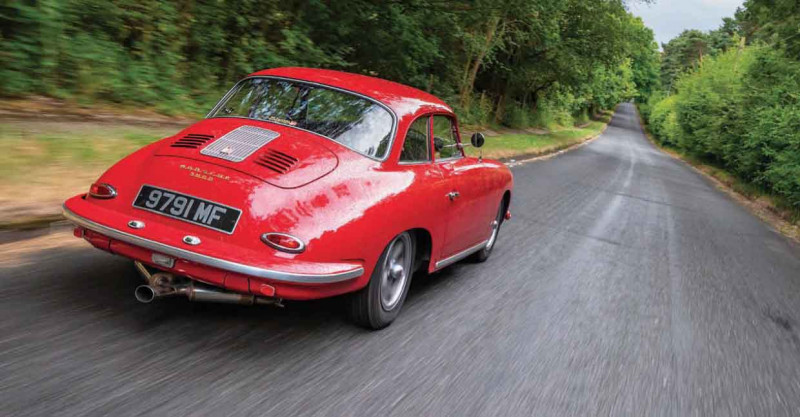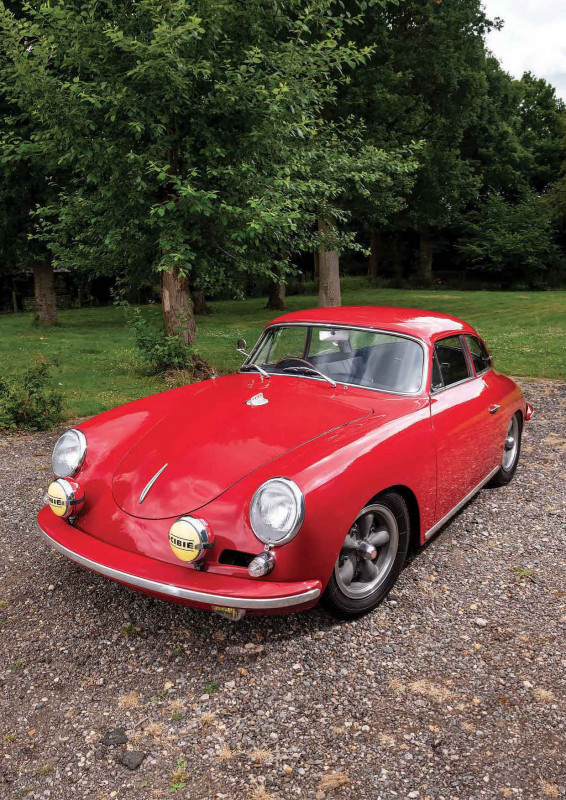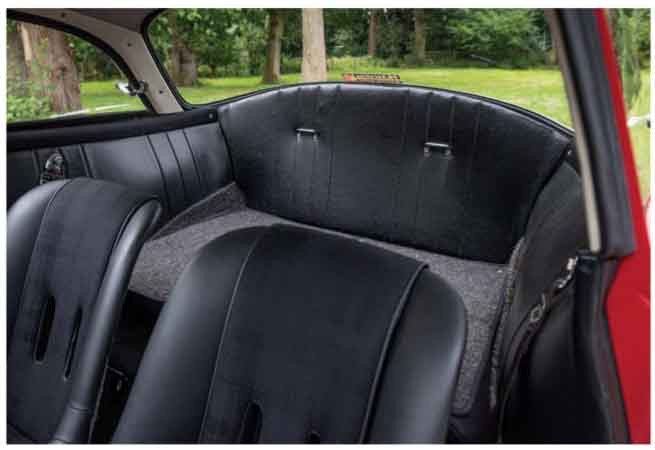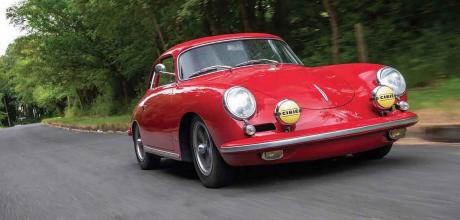1961 Porsche 356 B Notchback
We never tire of the Reutter 356’s teardrop lines, but the Karmann notchback is even more ofan eye-opener, especially when turned into a 356 GT by marque specialist, PR Services…
Words Johnny Tipler
Photography Dan Sherwood
NICE NICHE NOTCH
Rediscovering the 356 B notchback.
Before telling you about the refit of this unusual 356, let’s delve back in time. By 1960, the 356 was a well-respected model on the automotive scene, its fastback lines familiar to the cognoscenti. What wasn’t so established was the general perception of a coupé versus a grand tourer. A coupé was essentially a roadster with a hard-top, while a grand tourer was a sleek hardtop with a roofline sloping elegantly down to the tail (a fastback, in other words). Both relatively novel concepts in the grand scheme of things. What we have here is an extremely rare 356 B coupé, otherwise known as a notchback.

Just 2,229 examples were assembled by Karmann at Osnabrück between 1961 and 1962, using panels made by Reutter at Stuttgart and finished at the Porsche factory at Zuffenhausen. As for our feature car, what a gem! It’s presented as a 356 GT, very much in the spirit of how the factory might have configured the notchback as a competition car. The operation was carried out by PR Services, based in Billericay, Essex, and is a family affair insofar as boss man, Paul Smith, fashioned the unusual Porsche for his father, Mike, who previously visualized it as “an old man’s car”. Seeing how this radiant red 356 looks today, I’m inclined to disagree. Paul sets the scene. “The car came to us in 2003. It belonged to Don Betts, a longstanding PRS customer. He used to be an RAF pilot and trained rookie airmen to fly the English Electric Canberra, a twin-engined highaltitude jet bomber in service with the RAF between 1946 and 2006. Unfortunately, Don developed Alzheimer’s and was struggling to put the car back together after disassembly. We agreed to do the work for him. Unfortunately, his condition worsened and he passed away. Eventually, his widow wanted to sell the car and we were only too happy to buy it. We believe Karmann built nineteen notchbacks in right-hand drive. We know of five survivors. This is one of them.”

I ask Paul if he thinks that, back in the day, the notchback was seen as eccentric when compared with the 356’s better-known grand touring shape. “Anybody in the UK buying a 356 had to be a weirdo to start off with,” he laughs. “To buy a notchback, you had to be the weirdo of weirdos — you could buy two Jaguar E-Types for the same money. These Porsches were ridiculously expensive. Additionally, they were powered by a 1.6-litre engine, whereas the Jag made use of a 3.8-litre straight-six. You had to be a total connoisseur to want the 356 over a Big Cat.”
EVERYTHING IN THE ENGINE BAY IS PRETTY MUCH STANDARD FAYRE, INCLUDING THE HEAVY SOUND DEADENING MATERIAL

In 1954, Archibald Frazer-Nash (AFN) signed an agreement for the UK import of Porsche cars, which it sold from its premises on London Road in Isleworth, Middlesex. Two years later, AFN became the sole UK concessionaire for Porsche, an arrangement ending in 1965, when Porsche Cars Great Britain Limited was established. This change of operations successfully separated importing functions from sales. PRS is custodian of AFN’s archives, meaning Paul has direct access to data relating to UK-supplied, right-hand drive, early classic Porsches and their first owners. “We’ve got all the AFN cards,” Paul smiles, proudly. “We’ve noted how original owners of 356s tended to be architects, doctors or in equally highly respected professions. They were certainly educated people with enough disposable income to spend on what was, for the period, a very expensive car.” I’m reminded of how my personal interest in Porsches stems largely from when my father went backwards through a hedge in a 356. The car’s owner was one of the pioneers of battery chicken farming, who my dad knew from the local tennis club. They went for a spin, literally. Dad lost control on Danbury Hill (by coincidence, not that far from Billericay) and went backwards through scenery outside the Spinney hairdressers. In the context of the article you’re reading, this is, perhaps, information you consider supplementary to requirements, but it serves to support Paul’s assertion 356 ownership implied someone who wasn’t exactly run-of-the-mill.
THE FILLER CAP WAS RELOCATED BENEATH A TRAPDOOR ON THE RIGHT-HAND FRONT WING
Construction of the notchback was fundamentally different from the Reutter-built fastback shells — notice the notchback wears Karmann badges on its wings, as opposed to exhibiting Reutter emblems. In fact, 1961 was something of a milestone year for the 356 B, with Dutch-made Koni dampers now fitted as standard on the 1600 S and Super 90. Rear roll stiffness was slackened by one-millimetre-thinner torsion bars, plus a transverse leaf spring to aid torsional rigidity.

Three new variants entered production: the 356Convertible D Roadster (built by Stuttgart coachbuilder, Drauz), a 356 Roadster (by Antwerp-based d’Ieteren, which became Belgium’s Porsche concessionaire) and the Karmann-constructed 356 coupé, known as the notchback. The latter was similar to cabriolets equipped with removable hard-tops, but in this case, the hard-top was incorporated permanently and fundamentally into the lower bodyshell. “If you look at the T6 version of the 356 B, the leading-edge bulge above the windscreen is smoothed to deliver a proper roofline,” Paul summarises. “In simple terms, you can think of the T5 notchback as a cabriolet with a hard-top welded onto it. Reutter must have pressed all the panels and sent everything over to Karmann, where they were joined together.”
CONSTRUCTION OF THE NOTCHBACK WAS FUNDAMENTALLY DIFFERENT FROM THE REUTTERBUILT FASTBACK SHELLS
There’s another hidden subtlety. “If the notchback was purely a cabriolet with a hard-top, there’d actually be a lower frame,” Paul reasons. “What we see here is no lower frame and the roof welded directly to the body. The rear quarter-window on a Karmann is about an inch longer because of where the frame would have been. The interior window trims are also different on account of the longer glass. All of this is exclusive to the notchback.”

The wonderful Targa variants of the 996 and 997 spring to mind. Each utilised a cabriolet hull and had its complex sliding glass roof attached, complete with hatchback lid, though configured with fastback styling. A 996 cabriolet with hard-top fitted, meanwhile, resembles a notchback. With their particular hard-tops grafted into place, I speculate the 356 T5 and T6 notchbacks might have experienced disrupted airflow over the engine lid, as was the case when I occasionally ran a 911 with a holiday-mode roof box. Paul thinks not. “356 notchbacks didn’t have problems in that respect, but I’ve no idea about the aerodynamics of the whole thing. The only clearly different aspect is when you’re in the driving seat and you discover the glasshouse is massive. It’s like sitting in a goldfish bowl! Visibility is brilliant — you can see everything. Driving a Karmann notchback is a different experience from time spent in a 356 coupé.” The post-war concept of a sports car hard-top was generally to enclose a two-seater roadster cockpit. Think MGA or XK120. A grand tourer was more likely to be a two-plus-two. A streamlined fastback roof cladding a four-seater cabin was therefore more logical. The Karmann 356 notchback defies convention, covering, as it does, the 356 two-plus-two layout. “We love these Porsches,” avers Paul. “We stare at 356s coupes all day,but then a notchback rolls into the workshop and we’re bowled over by how amazing it looks.” He just happens to own a notchback with an electric sunroof. “That’s even weirder!” he laughs.

As you’d expect, he’s looked at the AFN data. Consequently, he’s come to the conclusion there were likely five notchbacks assembled with sunroofs, including left-hand drive cars. In any case, he thinks each would have been slightly different — no two were the same because there simply weren’t enough orders to standardise production.
Back to our star car. The price was forty grand, which Paul considered a bit steep for a 356 B in 2003. “It was a standard car,” he shrugs. “We’d built it up to factory specification at Don’s request. There was nothing trick about this Porsche in any way. After acquiring the car from Don’s widow, my father and I drove it around for a while, but then it was put to one side. Dad owns several 356s, including a Speedster, meaning he wasn’t stuck for an aircooled Porsche.
We were having a conversation about what he was thinking about buying to use as his daily. Contenders included an Alfa Romeo Giulia. A nice car, but a bit boring. I suggested calling the notchback into service.”
Paul persuaded his dad the notchback could be both revitalised and repurposed. “This is a rare car, which is why I didn’t want to interfere with its integrity in any way, but I considered the fact I had a spare bonnet, engine lid, bumpers, fuel tank and Speedster seats.” He set about removing extraneous ancillaries and began the conversion to what you see on these pages.
There’s a fine line here. “I wouldn’t describe this 356 as an Outlaw,” he says. “It’s a 356 notchback with a GT look.” Spotting those big Cibie spotlights up front, my first impressions is that it looks like a historic rally car. Paul describes how he arrived at the formula. “What would Porsche have done if it had produced a GT notchback? This question was my starting point. I reasoned my imaginary factory car would have carried a louvred aluminium engine lid and would have lost the standard bumper overriders. GT trims would have been fitted instead. Speedster seats and a Carrera 2 steering wheel would have been a must.”
And those Cibie rally lamps, of course. PR Services markets the appropriate brackets for the 356 A, allowing fitting of the lamps without drilling of holes into bodywork. Purely as a commercial venture, repurposing the notchback enabled Paul to ascertain whether asimilar bracket would work for a 356 B or C. In the end, it proved too insubstantial — the spotlight brackets could only be mounted where they are by drilling the bumper. “Typically, as is the case with virtually everything related to the 356, we were facing a bespoke solution to fit the spotlight bracket, which isn’t really what I was trying to achieve.” The panelwork was taken care of by Southendon- Sea-based Andy Barry, who fettled and fitted the front and rear lid. The paintwork was carried out by Simon Emery at The Paintbox in Coggeshall, a further member of the coterie of Essex-based automotive restoration specialists PRS employs.
Another task was to have the fuel filler located externally in the front lid, which meant swapping the fuel tank. “Continuing my thoughts about a factory notchback GT, I figured Porsche would have likely installed a quickfill facility. I cut my spare bonnet accordingly, flared around the edge of the hole and extended the fuel filler neck to enable the cap to be fitted. I then put a tray around the neck to catch rainwater. I also ran a drain hose in front of the fuel tank.” It wasn’t as much of a major task as it would have been with a T6. Ordinarily, to fuel up a T5, you have to open the bonnet and take the cap off the tank — there’s no external filler. In contrast, when the T6 was released, the filler cap was relocated beneath a trapdoor on the right-hand front wing.
Rest assured all modifications are entirely reversible. The original lids, for example, are hanging on the walls at PRS. “Within a day or two, the car could be put back to standard specification,” Paul assures us. “Change the wheels, put the old seats back in, reinstall the standard bonnet and bumpers. To a large extent, all we’ve done is bolt off and bolt on.”
There’s a great colour contrast between the red hue of the body and the anthracite of the wheels. These are original EMPI 5 split rims shod with Michelin radials. They certainly look the part. Indeed, if I was ever in the market for one of these Porsches, I’d have it configured per the PRS notchback, rather than as a standard car. “It’s exactly how I feel 356s are going,” endorses Paul. “Everybody talks about Outlaws, but the people building them are, more often than not, actually building GTs. Taking bumpers off and fitting a louvred engine lid is precisely what the factory did when manufacturing a GT. It’s not Outlaw.”
He goes a step further in his summing up. “On the whole, the younger owners we are presently coming across don’t really care about authenticity and matching numbers. Even my father, who is now eighty-two years old, doesn’t want a standard 356. He craves a GT. He wants his 356 to look like it is doing a hundred miles an hour when, in fact, it is sitting still.”
In the process of creating the GT look, Paul also played around with the car’s cabin. The upholstery work was carried out by Neil Tadman at Neil’s Auto Interiors, based near Southend. “We were faced with a bulky black interior and had a pair of Speedster seats to trim. If finishing them in the usual fashion, I reckoned the cabin wouldend up looking very ordinary. Tartan is obviously hugely popular right now, but it’s always very much ‘in your face’.
I wanted the pattern to be a surprise when you step foot into the cabin. With this in mind, I chose a really dark black tartan. It’s very subtle. The dash top and around the doors were also freshly trimmed.” The front and rear quarter-light windows open, providing extra ventilation, as and when required.
The steering wheel is, in fact, a pastiche of a Carrera 2 part — Paul reveals it is actually a standard wheel with its plastic broken off and recast to look like wood and epoxy. He admits inclusion of in-car entertainment presented something of a conundrum, primarily because it seems unlikely Porsche would have installed a radio in a 356 built to GT specification. Even so, the red notchback already had an aerial hole in its wing, leading Paul to retain the period radio and stick with the original aerial, rather than blank the hole. The engine and gearbox are original to the car, but considering PRS has all the tooling and facilities to swap things around, there’s a fair bet this nifty notchback will max out on engine capacity. “We’re working on the build of a higher output power unit for this Porsche,” Paul reveals. “When we’ve got mad ideas for engines, we’ll build them and use the notchback as our test mule. We plan to remove the original flat-four and put it to one side for safe keeping. My dad describes it as an old plodder, although he rebuilt it a couple of years ago.”
I enquire about the huge FRAM oil filter and the little gauge beside it. I’m told it replaces the dipstick. “The gauge provides an oil temperature readout. It’s perfectly safe to run the engine with the gauge in place, allowing you to confirm oil temperature quickly and easily.” A little sophistication and handy in a competition scenario, I suppose. Otherwise, everything in the engine bay is pretty much standard fayre, including the heavy sound deadening material, which might be just as well, depending on your idea of what a GT should sound like — the engine shouts through a throaty CSP exhaust. “It’s a product we sell,” Paul beams, “but it’s the only thing we changed on this engine. When we installed the system, we made covers and blanked the old exhaust holes.”
As for the suspension, the car sits slightly lower than standard, although Paul is dismissive. “It looks low, but it’s not really dropped for a GT fitout. On the subject, we make our own suspension bushes, which feature slightly harder rubber than standard replacement parts, meaning the front end is a little stiffer, something we benefited from when racing 356s in the 1990s. And we always run an eighteen-millimetre front anti-roll bar, which makes a 356 handle completely flat, resulting in a lovely drive.” PRS favours Koni suspension for the 356. “Never anything other than Konis for road cars,” Paul announces. “In truth, you don’t really have to do anything to the suspension. You can use a 356 on a track in the specification the car was in when it left the factory.”
The cause of going backwards down Danbury Hill, so he tells me, is the occupant of the driver’s seat. “356s give you a huge amount of feel for what they’re doing. You drive them with your backside. They tell you everything that’s going on.” As for the transformation from unsuspecting standard notchback to dramatic 356 GT, PRS has turned an already standout car into a piece of showmanship, which would be perfectly at home on the Rallye Monte-Carlo Historique, Le JOG or Tour Auto. That’s where I’d be heading.
Above The car announces its arrival through a throaty CSP sports exhaust system.
Above Notchback styling is rarely seen, but gives this flavour of 356 a unique look Facing page Engine and gearbox are original to the car, although PRS tells us a higher output flat-four is being prepared for this Porsche.
Above and below Retrimmed interior makes use of subtle monotone tartan cloth, including for the centres of the Speedster seats.
Above Spot lamps give the car a rally-ready appearance, enhancing GT styling alongside EMPI wheels.
Facing page From the front, the look of the notchback is familiar territory, but walk to the rear and you soon realise you’re in the presence of a different kind of 356


